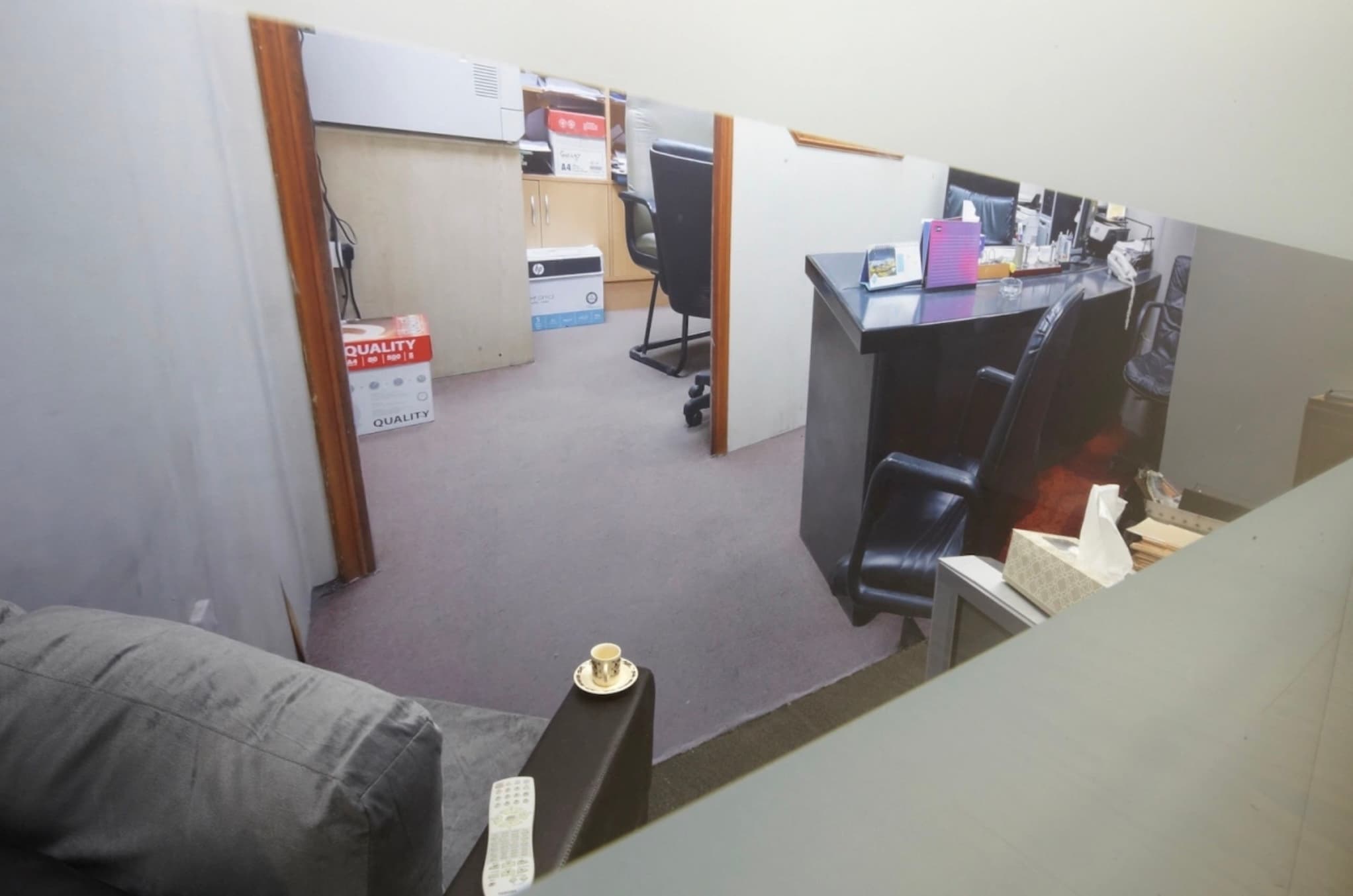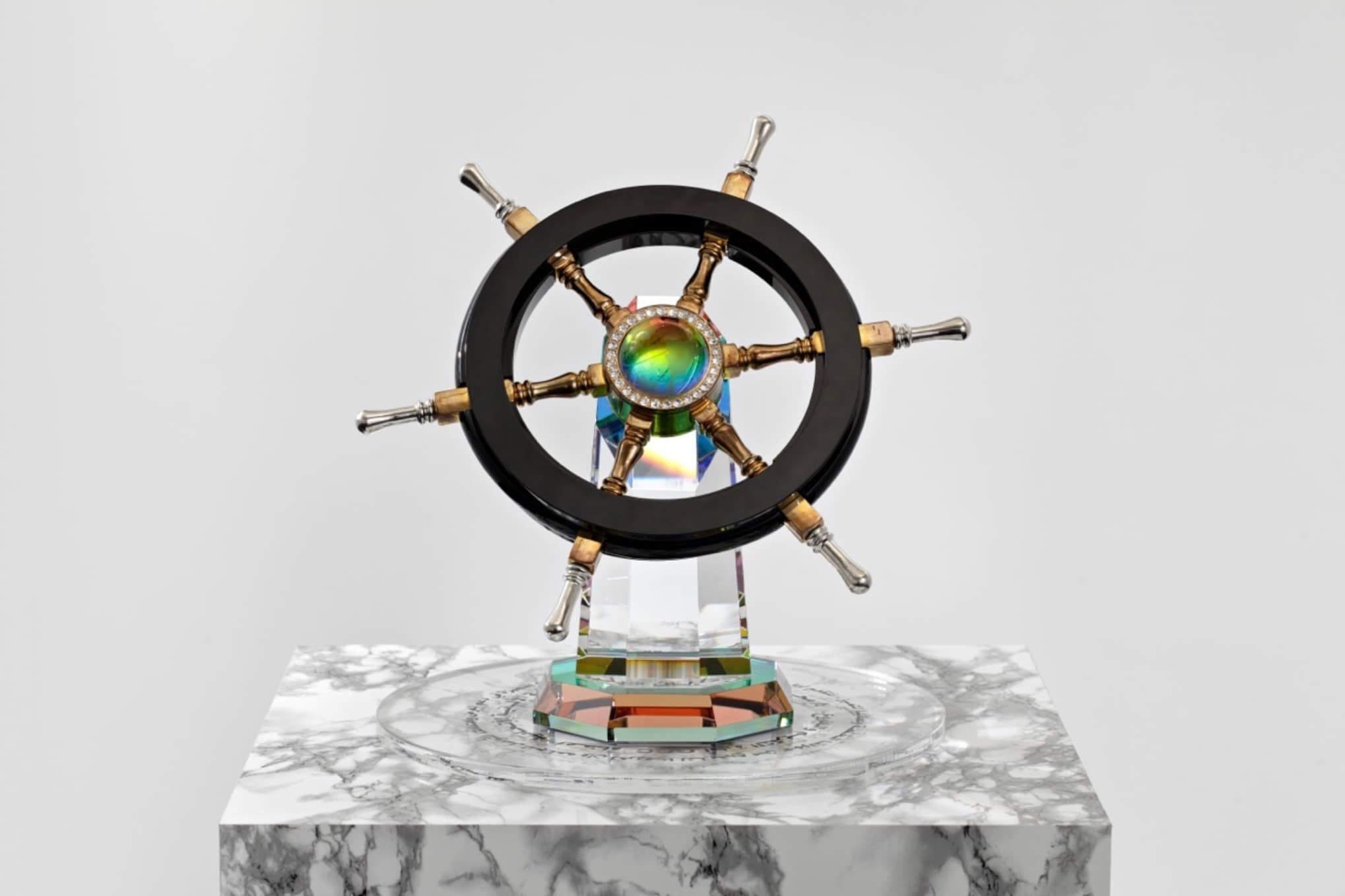Corporate Aesthetics: GCC at MoMA PS1
April 2014

In the 21st century, business and diplomacy look like the best of friends. Thanks to intergovernmental efforts to deregulate and homogenize financial markets, money can now travel largely unobstructed by national borders. Accordingly, contemporary globalized capitalism has developed a visual style all its own: distinctive enough to immediately signify taste and success, but bland and unobtrusive enough to be inoffensive in almost every context. It doesn't matter whether one is attending a conference in Dubai, sitting in a London office or looking through an in-flight magazine—the same homogenous aesthetic of shining wood furniture, plush carpets and well-groomed management consultants seems to prevail.
This look permeates the galleries of Queens, N.Y.'s MoMA PS1, now hosting "GCC: Achievements in Retrospective," the first North American exhibition of the GCC, an artist collective that takes its name and inspiration from the Gulf Cooperation Council. Like many other intergovernmental organizations, the Gulf Cooperation Council has vaguely stated goals that include promoting economic growth for its members, in this case Arab states in the Gulf region. And of course, international business diplomacy is not only about aesthetics: the sometimes-grandiose decisions made in this forum have real repercussions for everyone involved, perhaps most violently manifest in the brutal labor conditions of migrant workers. When GCC the artist collective—its nine members hailing from or maintaining connections to various Persian Gulf countries—appropriate the gestures and self-mythologizing imagery involved in diplomatic proceedings, they seek to uncover them as a kind of ridiculous theatre, rituals with no real meaning.
At MoMA PS1, an enthusiastic male voice, audible throughout the two galleries, assures visitors that the group's credentials are bona fide: "This official high-level strategic dialogue shows the bloc's commitment to an artistic union under an auspicious occasion that marks the diplomatic protocols observed." Part of a video titled CO- OP (2014), the script is set to a series of images playing on a flat- screen television. Clouds move past pristine mountaintops, fireworks explode over anonymous skylines and animated buildings shoot up like mushrooms from the sidewalks of a bustling CGI cityscape, beckoning tourists and investors to a place that has wealth and faith in the future.
The centerpiece of one gallery is a display of eight statuettes commemorating GCC's previous achievements: exhibitions in, for example, Berlin, Kassel, Kuwait, Beijing, London and now New York. The inscriptions feature the same self-congratulatory jargon as the video, saying things in Arabic or English such as, "We present ourselves with enormous gratitude and the deepest thanks for our outstanding contribution in support of this exhibition and our continued involvement in its success, and the honouring of ourselves springs from our loyal efforts and special dedication." Similarly, the walls are hung with photographs of meetings and ceremonies in pompous settings: a ribbon is cut, handshakes seal a deal, brows are furrowed over an important idea. The images appear to depict solemn events of high importance, though the exact meaning of the formalized interactions is left vague, as context-free as stock photography.
Despite their overall sleek aesthetic, many of the GCC's works contain hints of the facade's flimsiness. In actual stock photography, businessmen would not be wearing pajamas as a stand-in for traditional Arab dress. Nor would there be any evidence of a dingy back office, something that is, however, included in the show as an installation half-hidden behind a frosted glass screen. With its dull wall-to-wall carpeting and outdated electronics, the office is in stark contrast to the rest of the exhibition, revealing, perhaps, the gray tedium in which the rest of the show's opulent dreamscapes were produced.
According to the artists—Nanu Al-Hamad, Khalid Al Gharaballi, Sophia Al Maria, Abdullah Al-Mutairi, Fatima Al Qadiri, Monira Al Qadiri, Aziz Al Qatami, Barrak Alzaid and Amal Khalaf—this model of an office is also a representation of the relaxed attitude to work and the inefficient bureaucracies that prevail around the Gulf. The piece says with greater clarity what the others imply: there is nothing real that corresponds to these dreams. And that is why, for all the regional specificity of these portrayals, their message is universal. The language of financial success is scrubbed clean of the labor that created it, money becoming a placeholder with no necessary connection to value or work. Writing in one voice, the GCC responded to A.i.A.'s questions by e-mail.
KIRA JOSEFSSON How was your collective founded?
GCC A few of us were approached [in 2013] to work on a state- sponsored art project that was infused with a heavy dosage of bureaucratic wrangling. Our proposal—which referenced the bureaucracy surrounding the commission—was rejected, which gave us the impetus to create a formal unit of our own. We've collaborated in a variety of configurations over the past decade, and felt that as a collective we could draw on our ties in a way that could meld our various practices. In forming a "bloc" we can also address these overlapping topics that tie us together in a way that emphasized an anonymous shared experience of an environment rather than zooming in on the perspective of any one individual artist.
JOSEFSSON In corporations, individual performance is subsumed into the collective profit motive. This is manifest for example in business attire, the suit acting as a sartorial marker of anonymity. Does a similar dynamic also exist in GCC as a creative collective?
GCC Gulf businessmen have always been stereotypically portrayed as wearing traditional wear as a cheap Hollywood joke, but recently this trope is actually being used promotionally by the establishment in the region as a way to distinguish the now-powerful Gulf businessman as being part of a shiny new national brand. "National wear" has become an icon of wealth on one hand, as well as a link to "pure" Arab roots on the other; a win-win situation, acutely differentiating between the privileged locals, usually in managerial or administrative positions, and the expats, usually on the lower rungs of the ladder. We are interested in labor being seen as a suggestive act, with the emphasis being placed on the ritual of work, rather than the result. And the vagueness of working anonymously, or without having clearly prescribed roles, allows us to explore these themes further.
JOSEFSSON As a collective, living all over the world, what is your creative process like? How did you end up with the specific works you are currently showing at MoMA PS1?
GCC We communicate constantly on a number of online platforms to share ideas, but whatever concepts or material we bring up are concretized during our summits and the conversations that follow. We've had three summits so far, our first in Morschach [Switzerland], a second in Kuwait to plan the show at PS1 and most recently a New York summit to discuss future proposals.
So this constant communication results in a really organic conversation, and we enjoy bringing in other "delegates" to the conversation. Christopher Lew, who curated our show at PS1, was really instrumental in helping us to home in on what intervention we were making in the platform of the "retrospective." The works shown at PS1 were exhibited originally at four separate exhibitions.
Christopher identified a similar theme of achievement running through the exhibits and had the idea of combining selected works to be shown as a "retrospective," albeit a premature one, since GCC is only a year old. CO-OP, the new "promo" video work we created, serves as an anchor for that intervention. Within one space we collapse past, present and future achievements into a single experience.
JOSEFSSON Your work is humorous in its unmasking of the emptiness of corporate and state rituals. But what else do you hope to communicate?
GCC We view our work as incessantly sincere, a kind of positive realism. The emptiness of these gestures is not only a business trope, but also a reflection of higher power structures. There is something really crucial about the extent to which government bodies secure and deploy power through ritual, ceremony and the object. Many of the ambitious plans currently in development in the Gulf can be viewed as nationalistic campaigns using the guise of "luxury development" to push forward a "pure" unified national brand. These rituals and ceremonies thus become the visual performance of this national brand; they instate a kind of allegiance.
JOSEFSSON Do you see your work as a simulacrum of business? How can simulacra and irony change the viewer's interpretation of these pieces?
GCC Our work is more akin to a simulacrum of diplomacy— diplomacy as an international language, presented in our regional vernacular. There is an undeniably close relationship between contemporary corporate and diplomatic discourse; however, the latter is richer in pomp and protocol. Aesthetically, our work deals with the absence of labor, the import of foreign objects that have gained local meaning through filters of engagement. More than simply using corporate aesthetics as a static reflection of the "mundane," our use emphasizes the active discrepancy between the high-rise super- developments in the region and the absence and dysfunction of local labor.
Irony and simulacra expose the viewer to significant societal transactions that are taken for granted or possess covert meaning. Re- contextualized, what is seen as business as usual is revealed as carefully orchestrated performances of work.
Kira Josefsson
